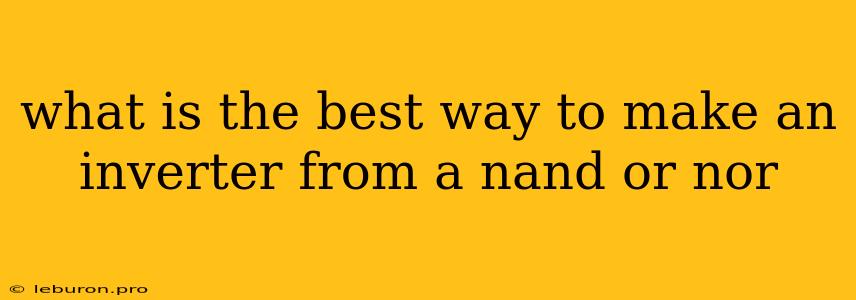Creating an inverter using only NAND or NOR gates is a fundamental concept in digital logic design. Inverters are essential components in digital circuits, acting as the building blocks for more complex logic operations. While inverters are readily available as individual components, understanding how to construct them using basic logic gates provides a deeper understanding of digital circuit design principles. This article explores the methods for building inverters using NAND and NOR gates, providing a comprehensive guide to the process.
Understanding Inverters and Logic Gates
An inverter is a fundamental logic gate that performs the logical NOT operation. It takes a single input and produces an output that is the opposite of the input. If the input is high (logic 1), the output is low (logic 0), and vice versa.
NAND and NOR gates are universal logic gates, meaning that any other logic gate can be implemented using only NAND or NOR gates. They are crucial for building complex circuits.
- NAND gate: A NAND gate outputs a low signal only when all its inputs are high. It's represented by a symbol with an inverted output.
- NOR gate: A NOR gate outputs a high signal only when all its inputs are low. It's also represented by a symbol with an inverted output.
Building an Inverter using a NAND Gate
One straightforward method for constructing an inverter is by using a NAND gate. Here's how:
- Connect the input signal to both inputs of the NAND gate. This effectively ties the two inputs together.
- The output of the NAND gate will be the inverted version of the input signal.
Let's break down the logic:
- When the input is high (logic 1), both inputs to the NAND gate are high. Since NAND gates output low only when all inputs are high, the output will be low (logic 0). This matches the inverter's behavior.
- When the input is low (logic 0), at least one input to the NAND gate is low. In this case, the NAND gate outputs high (logic 1), again fulfilling the inverter's function.
Truth Table
The truth table for a NAND gate inverter illustrates this clearly:
| Input (A) | Output (A') |
|---|---|
| 0 | 1 |
| 1 | 0 |
Building an Inverter using a NOR Gate
The same principle applies when constructing an inverter using a NOR gate. Here's the procedure:
- Connect the input signal to both inputs of the NOR gate. Similar to the NAND gate approach, the inputs are tied together.
- The output of the NOR gate will be the inverted version of the input signal.
The logic behind this is:
- When the input is high (logic 1), both inputs to the NOR gate are high. Since NOR gates output high only when all inputs are low, the output will be low (logic 0), as expected for an inverter.
- When the input is low (logic 0), at least one input to the NOR gate is low. In this case, the NOR gate outputs high (logic 1), matching the inverter's function.
Truth Table
The truth table for a NOR gate inverter demonstrates this:
| Input (A) | Output (A') |
|---|---|
| 0 | 1 |
| 1 | 0 |
Importance of Inverters
Inverters are crucial components in digital circuits for several reasons:
- Logic Inversion: They provide the essential function of inverting logic signals. This is fundamental for various logic gates and operations.
- Complementation: Inverters are used to complement signals, which is critical in designing logic circuits that require both true and complemented versions of a signal.
- Signal Manipulation: Inverters enable manipulation of signals to control the behavior of other components in the circuit.
Conclusion
Understanding how to construct an inverter using NAND or NOR gates is essential for anyone studying digital logic design. This process underscores the universality of these logic gates and their ability to implement a wide range of logic functions. By connecting the input signal to both inputs of a NAND or NOR gate, you can create an inverter that performs the logical NOT operation, effectively inverting the input signal. The concept of inverters, combined with the understanding of NAND and NOR gates, forms the foundation for building more complex and sophisticated digital circuits. So, the next time you encounter a digital circuit diagram, consider the fundamental building blocks, like inverters, and how they are implemented using basic logic gates.
